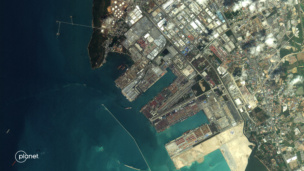Colorado Springs, CO—President Donald Trump wants a space-based missile defense system. He wants it to be gold, and he wants it now.
L3Harris outlined its strategy to give the president what he wants yesterday at the Space Symposium conference—with an emphasis on fielding proven technologies as soon as possible, and worrying about the finer details later.
“I don’t think the patience is there with this administration to wait too long,“ Scott Alexander, L3Harris’ president of missile solutions, told reporters. “Perfect is the enemy of good enough.”
Today and tomorrow: Leaders from L3Harris argued that the company has already demonstrated many technologies that will be central to the Golden Dome architecture.
- The company has won contracts to supply 38 satellites across all three tranches of the SDA’s Proliferated Space Warfighter Architecture.
- A prototype of the company’s HBTSS satellite—the Hypersonic Ballistic Tracking Space Sensor—has already demonstrated the ability to detect and track ballistic missiles.
- The company also stood up MOSSAIC, a series of ground-based sensors that forms the basis of Space Force and US Space Command’s space domain awareness architecture.
“We’re ready to go. I mean, time is our enemy here,” said Ed Zoiss, the company’s president of space and airborne systems. “I hope the first thing that happens is we decide what works and we start into production on that, while we develop the things that we know are going to take longer.”
In anticipation of DoD’s shift to proliferated systems, L3Harris significantly ramped up their production capacity, opening a new rocket motor factory in December, with plans for a payload processing facility and a vehicle integration facility in the coming months.
ETA? While L3Harris argued that they’re ready to start production on the Golden Dome, there are open questions on what the final product will look like, and when the tech will be ready.
For one, the technical aspects of space-based interceptors have yet to be demonstrated. The Golden Dome’s aim is to take out enemy missiles in their boost phase, which will likely require an orbital weapons system. While ground-based interceptors have perfected the art of defense, space-based alternatives are not fully fleshed out.
One of many: L3Harris is far from the only company putting together a Golden Dome plan. Booz Allen put forward its plan last month, and True Anomaly CEO Even Rogers told Payload that the startup is also positioning for the program.




